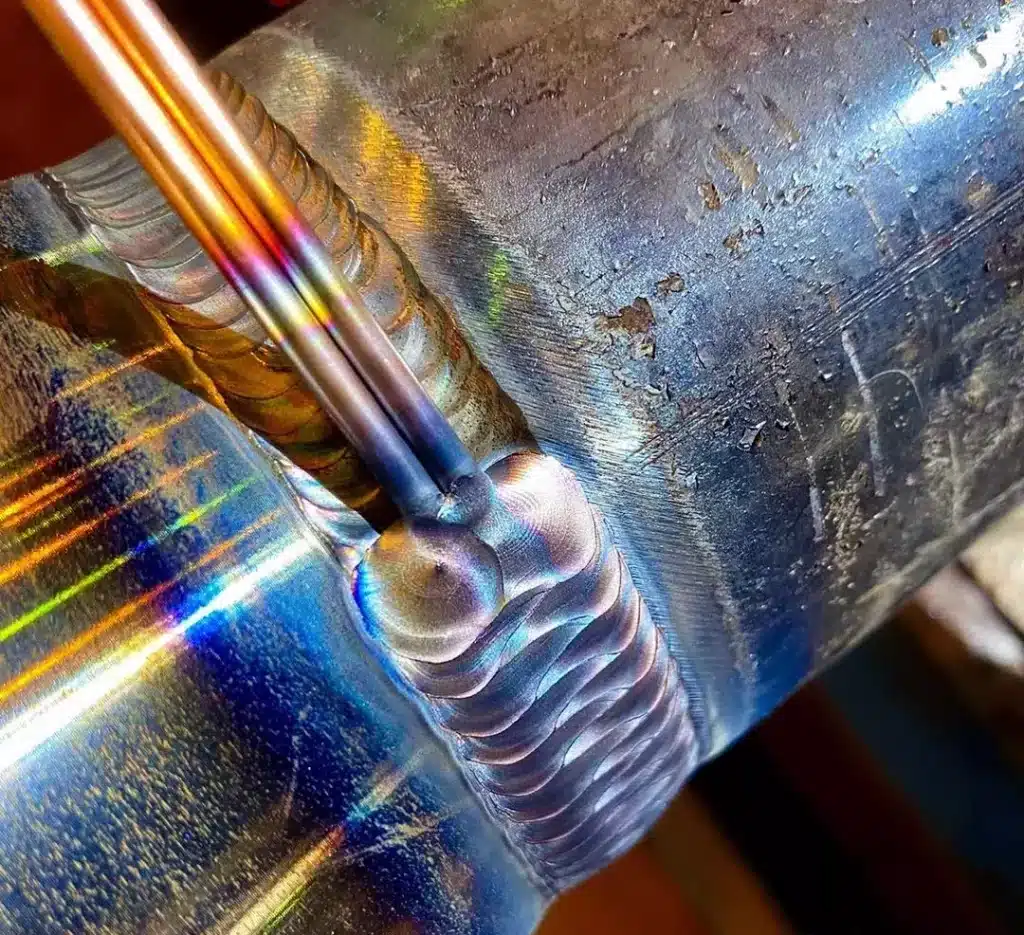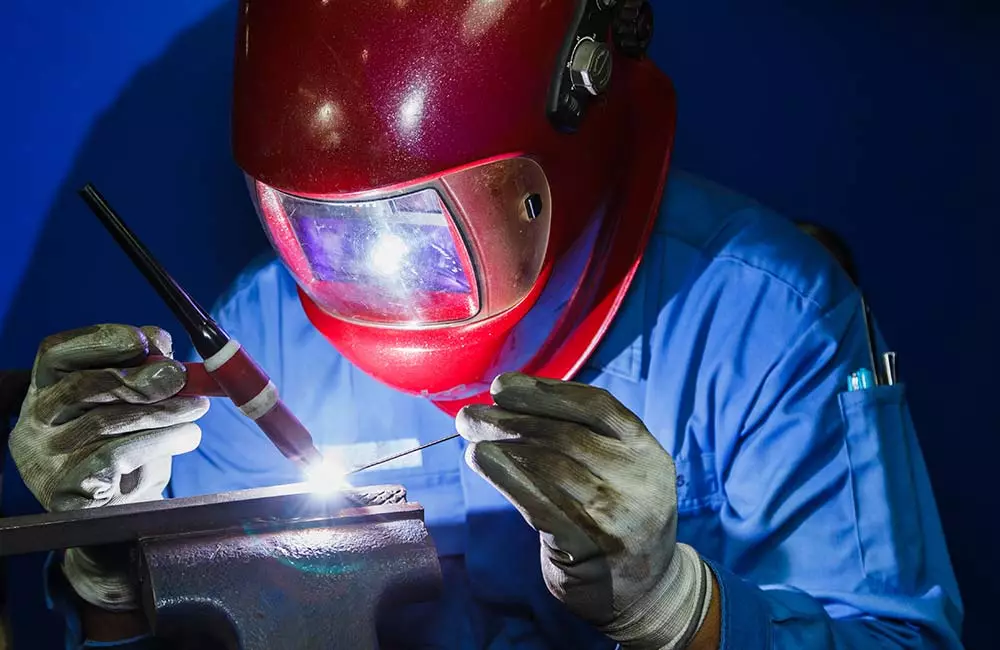Gas Tungsten Arc welding utilizes a tungsten electrode to produce an electric arc that melts the metal and fuses it together. To control the welding process, TIG welding machines offer two different output polarity settings: DCEN (Direct Current Electrode Negative) and DCEP (Direct Current Electrode Positive).
These polarity settings have a different impact on the welding process, including how the metal melts, the level of penetration, and the quality of the finished weld.
In this article, we will explore the difference between DCEN and DCEP in TIG welding, which will explain how to choose the right TIG welder settings for your next welding project.
TIG Welding With DC Current
Tungsten Inert Gas welding is a process that uses a non-consumable tungsten welding electrode to deliver current while shielding the weld area with an inert gas such as argon. This process offers the benefits of high weld quality, good weld control, and the ability to join materials of different thicknesses. It can be used on a wide variety of materials such as aluminum, steel, stainless steel, titanium, brass, and copper with excellent results.
TIG welding can utilize either AC or DC current to produce a welding arc. However, DC TIG welding takes nearly 90% of all TIG welding since it is suitable for mild and stainless steel, which is likely to be the main component of most of your hobby, DIY, or home projects.

AC current is used when welding aluminum or non-ferrous metals that have n oxide layer on the surface. When choosing the DC current, you can select the following TIG welding settings over the polarity: DCEN (Direct Current Electrode Negative) and DCEP (Direct Current Electrode Positive).
They represent the side of the circuit where the electrode (TIG torch) is connected. This affects the current flow and, eventually, the welding performance. So let’s see what the differences are.
DCEN TIG Welding
In DCEN TIG welding, the torch is connected to the negative terminal of the TIG welder and is often referred to as Direct Current straight polarity. The avalanche of electrons is liberated from the electrode and flows toward the base plates. Due to the presence of sufficient potential difference, electrons are accelerated between the electrode and weld metal and, finally, strike the base metal surface at a very high velocity. Upon striking, the kinetic energy of the electrons is converted into thermal energy, and thus immense heat is generated.
The heat distribution in the arc is around 33% on the negative side of the arc (electrode tip) and 67% on the positive side of the arc (the workpiece). As more heat is concentrated at the weld pool, this results in increased penetration into thicker metals and allows for stronger welds with the better overall quality.
The increased heat concentration afforded by this method provides deeper penetration and weld strength while producing less spatter than other types of welding processes, making it easier to clean up afterward. This reduced heat in the electrode allows more current to be carried by smaller electrodes compared to other polarity connections.
As a result, DCEN is one of the most commonly used TIG welder settings for common mild steel and stainless steel. Nearly 90% of all TIG welding is carried out at straight polarity, and your TIG welder is usually set for it by default.
Advantages of DCEN (Direct Current Electrode Negative) in TIG Welding
- Deep penetration
- Proper fusion
- Wide HAZ provides good joining action
- Good for steel welding
- Good for thicker pieces
- Since heat is not concentrated onto the non-consumable electrode, welders can use smaller diameter
DCEP (DC+) TIG Welding
Direct current electrode positive (DCEP) polarity is also referred to as “Direct Current reverse polarity” since the torch is connected to the positive terminal of the TIG welder. The electrons flow from the base plate towards the electrode. Accordingly, the majority of the arc heat is generated at the electrode surface, while less heat is generated on the base metals surface.
The heat distribution in the arc is around 33% on the negative side of the arc (the work piece) and 67% in the positive side of the arc (the welding torch). As a result, there is significantly lower penetration compared to DCEN polarity in TIG.
This kind of distribution results in high heat build-up on the electrode and TIG welding torch, but it leads to a higher filler deposition rate. Therefore, you must use a larger diameter non-consumable tungsten electrode capable of withstanding high heat. High heat on the torch means you should consider using a water-cooling system to avoid failure. Additionally, DCEP has issues with arc blows more often. Even though this phenomenon can occur with DCEN due to the magnetic or thermal properties of base metal, it is more commonly associated with DCEP TIG welding.
Even though it is not capable as DCEN, DCEP has its advantages. The most significant one is the cleaning action. As the current flows towards the electrode, the electrons remove the oxide layer from the surface of the base metal. These oxides are usually found in metals such as aluminum or stainless steel, and they offer unique properties such as corrosion resistance.
However, they have different melting points compared to the base material, so you have to remove them prior to welding. Nonetheless, they start forming once the surface is exposed to air, so you have to weld them quickly after grinding and removing them. With DCEP, this is much easier, as the current itself removes and prevents oxide formations. Therefore, you can theoretically use DCEP polarity when TIG welding aluminum, but AC welding is always a better choice.
Advantages of DCEP (Direct Current Electrode Positive) In TIG Welding
- High filler deposition rates
- Higher welding speeds and increased productivity
- Good cleaning action over covered electrodes
- Narrow HAZ suitable for thin metals
- Less risk of distortion or burn-through on thin metals
- Removes surface oxide
DC TIG Welders
DC TIG welder is your go-to choice if you are looking for an affordable TIG machine, and most of your projects include welding mild steel and stainless steel. They are available as transformer or inverter power sources, but inverter TIG welders are more common today due to higher versatility, power and welding efficiency, and lower price. You won’t have to break the bank to buy a DC-only welder, but you will still get enough.
However, if your welding projects include welding aluminum or non-ferrous metals, you will need to choose an AC/DC TIG welder. This welder will operate similarly at DC current, but you get an AC TIG welding option when welding aluminum or other non-ferrous metals. However, they are pricier, so you’ll have to set your goals straight before purchasing. Still, if you are just learning how to TIG weld, you will be more than fine with a simple DC TIG machine.
Differences Between DCEN and DCEP In TIG Welding
| DCEN | DCEP |
| The torch is connected to the negative side of the terminal | The torch is connected to the positive side of the terminal |
| Electrons flow toward base metals | Electrons flow toward the tungsten electrode |
| Heat builds up on the surface of the base metal, resulting in higher penetration | Heat builds up on the TIG torch, requiring larger tungsten and better cooling |
| Great fusion and penetration for thicker pieces | Lack of fusion on thicker pieces |
| Possible distortion and wrapping on thin pieces | Less risk of distortion, burn through wrap when welding thin plates |
| Low electrode consumption but lower deposition | High consumption of non consumable electrodes but also better filler deposition |
| Broad heat affected zone | The more narrow heat-affected zone |
| Good for metals with high melting temperature | Good for delicate metals |
| No cleaning action of the arc | Cleaning action removes the oxide layer |
| More stable arc | Arc blow can occur |
What Is The Best Polarity For TIG Welding, DCEN or DCEP?
The answer to the best TIG welder settings will depend specifically on your applications.
DCEN takes nearly 90% of all TIG welding due to its ability to work well and provide adequate penetration on a fusion on medium-thickness and thick steel, stainless steel or titanium, or basically any metal with a higher melting point. The broad HAZ will produce strong and reliable welding joint on thicker pieces, so you don’t have to worry about defects or weld failure.

Meanwhile, DCEP TIG welding works well when you are dealing with metals with low melting point and oxide surfaces, such as copper or aluminum. Since more heat is concentrated onto the welding torch, there is a lesser risk of distortion, wrapping, or burn-through on thinner or delicate pieces. Additionally, cleaning action removes the oxides that form on the surface of the weld when exposed to the atmosphere. These oxides can cause issues due to different melting point from base metal, so cleaning action is crucial.
The all-around choice is an AC TIG welding setting, where the current alternates from the cycle’s positive to the negative side. Advanced AC/DC TIG welders will allow you to select the balance between penetration and cleaning, or the time spent on the positive and negative side of the cycle, so you get sound out of both sides of polarity. Still, DCEN TIG Welding is a go-to choice in a most common hobby, DIY, or occasional welding applications.
Final Thoughts
Understanding the difference between DCEN and DCEP in TIG welding is critical for achieving the best results from your welding projects. Both polarity settings have their advantages and disadvantages, and the right setting for you will depend on the material you’re welding, the thickness of the metal, and the desired outcome.
By selecting the right polarity setting and adjusting your welding parameters accordingly, you’ll be able to produce clean, strong, and precise welds every time. Keep in mind that we are talking about polarity strictly in TIG welding, while it can show different results in Stick welding or MIG fusion welding process.
Resources
- https://www.jasic.co.uk/differences-between-tig-dc-and-ac
- https://www.twi-global.com/technical-knowledge/faqs/faq-when-manual-metal-arc-welding-which-electrode-polarity-should-i-use
- https://weldingweb.com/vbb/threads/58039-DCEN-vs-DCEP-All-my-sources-have-conflicting-info
- https://www.sciencedirect.com/science/article/pii/S2468227622002368
- https://link.springer.com/article/10.1007/s11465-007-0076-9





